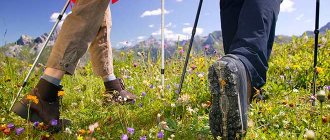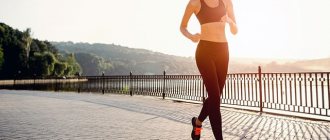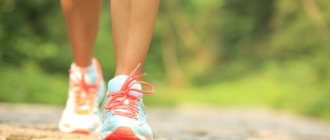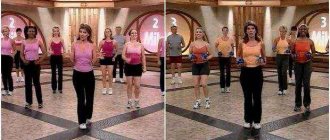Europeans are accustomed to paying quite a lot of attention to their health. Particularly popular among them is Nordic walking for the elderly, which helps keep your body in good shape without unnecessary stress. Today we will try to expand on this topic and help you choose equipment for beginners.
The undeniable advantage of this type of activity is its accessibility. Nordic walking can be practiced by people of any age. Moreover, it is absolutely safe. Numerous studies have confirmed the beneficial effects of exercise on the entire body as a whole.
The essence of classes and their benefits for the elderly
I want to say right away that Nordic walking is a whole complex of physical therapy. During classes, almost all muscles are worked out. The special position of the body eliminates excess loads.
The essence of the method is as follows: by walking in the fresh air with the help of special devices called sticks, you activate every cell of your body. The benefits of exercise are especially noticeable for people who require gentle rehabilitation and strengthening of the body.
Let's consider how such gymnastics is useful:
- gentle training of the cardiovascular system;
- strengthening the respiratory system;
- decreased blood sugar levels;
- saturation of body cells with oxygen;
- formation of stable immunity;
- prevention of osteoporosis due to increased vitamin production
I would also like to note that group walking exercises are considered an excellent opportunity to make new acquaintances and relieve stress.
How to reduce blood pressure
It is difficult to overestimate the effect of Nordic walking in the prevention and treatment of hypertension. During training, blood vessels in muscles under load dilate, which leads to a decrease in the so-called total peripheral resistance, which in turn has a positive effect on lowering blood pressure.
You may have noticed that after training with a normal load, high blood pressure tends to decrease. In addition, normalization of pressure after exercise is one of the criteria that allows you to control the permissible load.
I will say more, there are a lot of medical studies according to which, in patients with hypertension who were exposed to moderate aerobic exercise for several months, systolic and diastolic pressure significantly decreased.
Scientists have found that an increase in the body's aerobic capacity, measured by the level of maximum oxygen consumption - VO2max, in most cases naturally leads to a decrease in blood pressure.
Honored Worker of Physical Culture of the Russian Federation, Candidate of Medical Sciences Evgeniy Grigorievich Milner, published data from his long-term observations of lovers of running and walking, where he wrote, in particular, that at the end of the training, systolic pressure in all subjects decreased by 20-30 mm, and sometimes more.
A steady decrease in blood pressure was observed among recreational walking enthusiasts with three or four workouts per week for one and a half to two years.
But what about hypotensive people? How Nordic walking can affect the increase in blood pressure if hypertensive patients experience a decrease in blood pressure. Observations by E.G. Milner and other scientists prove that aerobic exercise has a positive effect on the regulation of vascular tone in the body, which leads to normalization of blood pressure both in the case of hypertension and hypotension.
Nordic walking rules
Despite its apparent simplicity, this kind of activity should be approached with the utmost seriousness. After all, the body is under significant stress. The training program includes several stages:
- Warm up.
- Walking.
- Hitch.
Don’t be lazy and be sure to pay enough attention to each point. Otherwise, instead of improving your health, you risk getting the opposite effect.
Let's look at each stage in more detail. Warm-up is carried out with the aim of warming up the muscles, joints and preparing the entire body for the upcoming loads. Here is a sample list of exercises:
- circular rotations of the head 8 times in each direction;
- warming up the shoulder joints. Bend your arms at the elbows and touch your shoulders with your fingers. Rotate your arms forward and backward 8 times in each direction;
- tilting the body back and forth, left and right. 8 times;
- warming up the hip joints. Place your hands on your hips and rotate your pelvis in a circle 12 times;
- circular rotations of the knees clockwise 8 times and counterclockwise the same amount.
Afterwards, you should start walking. You should also complete your workouts gradually to reduce fatigue and minimize stress on the body.
Cool down after Nordic walking exercises
- from a standing position, sticks in hands, lean forward and down. Gently stretch the spine;
- raise the stick in your hands above your head and bend to the side, do not bend your arms;
- arms extended in front of you, stick in hands. We make side turns without bending our arms;
- swing your legs back. Support yourself on poles, smoothly move your leg behind you.
Repeat each exercise 8-12 times depending on your general condition.
Nordic walking technique
Now I want to tell you how to practice Nordic walking correctly and achieve excellent results.
Instructions:
- How to step: The width of the step is slightly wider than usual. The heel of the walking foot should be located where the stick touches the ground. Knees and elbows are slightly bent. When the right foot steps, the left hand brings the stick forward.
- Breathing: only through the nose. If it’s difficult to do this right away, you can inhale through your nose and exhale through your mouth. It is optimal to inhale for 2 steps, exhale for the next 3-4 steps.
Also make sure that when walking, the pole laid back is at an angle of 60 degrees. And don't be afraid, the stick won't slip out of your hands. It is equipped with a special belt that securely fixes the product on the hand.
Here are a few more subtleties about moving with sticks, told to me by experts:
- You need to push off more energetically with your back leg;
- when the arm is pulled back, you need to relax the hand and give it the opportunity to rest;
- always keep your back straight.
The video shows the most common mistakes during Norwegian walking. I highly recommend watching them and protecting yourself:
Winter clothes
I hope you will become interested in Nordic walking and walk all year round. Winter outdoor training - skiing, running, walking, etc. - requires additional clothes. General principles: drain water, dress in layers, protect mouth and nose. If you decide to switch to running/cross-country skiing, you won't have to buy anything new.
Thermal underwear In winter, you need not only socks, but also a thermal T-shirt for your body, and at temperatures below -10 °C - thermal pants. Thermal underwear wicks away sweat, reducing the risk of hypothermia. Additionally, good thermal underwear tightens the muscles - this slightly reduces fatigue and speeds up recovery after long distances.
Thermal underwear should be bought a size smaller; it should stretch easily and fit like a second skin. Loose thermal underwear does not work. I recommend the Accapi ERGOracing series.
Good thermal underwear is flattering - it makes everyone look like glamorous cyborgs
A few more features of the classes
In order for the training to take place in a calm mode and really strengthen the body, you need to know some features:
- You can exercise at any time of the year. In summer, training is carried out in the morning or evening hours, when solar activity is as low as possible. In winter, you will have to slow down a little, this will protect you from dangerous injuries and reduce the risk of slipping.
- Breath control. In old age, any improper impact immediately affects the heart muscle and respiratory system. Therefore, during classes it is important to adhere to the basic rules of breathing exercises.
- Regular breaks. Do not abuse it and bring the body to exhaustion. Stop every 15-25 minutes depending on your training.
- The optimal duration of classes is 3-4 hours once a week for no more than 60 minutes.
It’s okay if you experience minor pain during the first few sessions after classes. This is just the body’s reaction to the activity of muscles that were previously simply deactivated due to their passivity.
Blood pressure table
| age | Normal systolic pressure | Normal diastolic pressure |
| 16-29 years old. | from 90 to 130 | from 50 to 80 |
| 30-39 years old. | from 90 to 130 | from 60 to 90 |
| 40-59 years old. | from 90 to 140 | from 60 to 90 |
| 60-69 years old. | from 100 to 150 | from 90 to 94 |
I don’t know how much you can rely on these data, I always believed that age-related changes in blood pressure, like, for example, weight gain, are understandable, but not desirable, since high blood pressure causes the development of atherosclerosis, which is relentlessly followed by heart attacks and strokes.
My opinion is based on the ruling of American and European cardiologists, who consider pressure to be from 120/70 to 140/90 normal and regard an increase in the upper limit as pathological and requiring treatment.
Tips for choosing ammunition
The hardest thing for beginners will be choosing poles. There are a lot of them and the cost can vary greatly. Therefore, I propose to consider the key points when choosing:
- length. To correctly determine its value, you need to multiply your own height by 0.68 and round the result to the nearest number that can be divided by 5 without a remainder. For example, your height is 165 cm. We count: 165*0.68=112. The closest multiple of 5 is 110. This will be the optimal length of the stick;
- quality. It’s better to buy a new item right away than to try several used ones. The walking stick is selected very individually, so you need to take the choice seriously;
- pens. You should never buy products with plastic handles. Although this material is somewhat cheaper, it behaves very poorly during classes. The handle should fit snugly in your hand and not slip;
- carbon content. The stores offer products made from aluminum alloys and carbon and fiberglass compounds. The percentage of carbon fiber is the main indicator of high quality, but at the same time it greatly increases the cost of the model;
- vibrations. While walking, they are inevitable, but a high-quality pole should reduce them as much as possible, so you will get the maximum benefit from the exercise;
- tips. I strongly recommend purchasing several replacement pairs at once. And I definitely don’t recommend buying poles with permanent tips. Their service life is very limited and will lead to additional material costs.
Important! By winter, you need to purchase special tips designed for walking on snow.
Types of pole designs
I think it’s important to note those available for sale:
- Whole. Represents a hollow object with fixed dimensions. It should be selected as much as possible, having calculated the correct dimensions, since in the future it will not be possible to correct them. The downside is that this type of product is only suitable for those who prefer walking on the same terrain. The simplicity of the design guarantees the high strength of the stick.
- Telescopic. They have several positions, allowing use by several people with different parameters. It should be noted that the more sections, the less reliable the design. It is in these places that the risk of breakdown increases. But telescopic models are called compact for a reason - they can be folded and easily fit even a small handbag.
Now let's talk about other, no less important elements of athletes' equipment.
What else might be useful?
You need to start with preparing sportswear. Here I advise you to adhere to the following rules:
- dress according to the weather and listen to your physical condition. It is almost impossible to freeze while walking, but you should not experience discomfort;
- shoes. Buy special sneakers designed for running or walking. They have the most competently formed sole and during exercise the body weight will be correctly distributed;
- Any clothing chosen must be breathable. In this case, your body will be able to remain functional longer, which means you will get more benefits from training.
Additionally, you may need the following items on your hike:
- Backpack. You will put all the necessary things in it.
- Water bottle. Adequate fluid intake is considered an integral part of athletes.
- Pedometer. He will be able to record your next achievements.
- Replaceable pole tips. For convenience, they can be changed depending on the surface on which you will walk.
As you can see, the starting set for a novice athlete is not that big. Manufacturers offer a wide range, so everyone can find ammunition to their liking and budget.
Alternative workout
For runners, this is general physical training, skiing, swimming, cycling or Nordic walking. It's great if you can afford a pool, but I'm assuming you don't have time for it (I didn't). Just walk for half an hour - say, on the way to work, get off at a couple of metro stations in advance or park in the next block.
By the way, the best thing you can do if you drive to work is to stop driving to work.
You will have a road to the metro and to the office in two directions, which in total will give you about an hour of walking a day.
Contraindications to classes
I would like to remind you that any load should be taken very seriously, even if we are talking about such a safe form of activity as walking. Before starting training, I would recommend visiting specialists and, if necessary, undergoing a study.
In some cases, gymnastics can cause serious harm. Let's look at who should not use this technique:
- Injuries to the arms and shoulder joints.
- High blood pressure.
- Flat feet.
- Anemia.
- Heart failure.
- Changes in the joints and lower spine.
- During rehabilitation after abdominal surgery.
In addition, walking is extremely undesirable during the development of viral or infectious diseases. You should start training if your body is in good condition.
Ignoring these points can lead to a worsening of the situation and serious health problems. Therefore, you should always start training thoughtfully and sensibly assessing your capabilities.
What pressure is considered normal?
First, let's look at what pressure is considered normal for people of different ages.
The data given in the table below can only be used as a guide; as in any business, there are a lot of nuances, and your normal blood pressure may well differ from the statistical average. I assume you know that blood pressure is measured in two ways, systolic and diastolic. The term systole comes from the Latin word sustole, which means compression, so the systolic pressure readings will be the highest.
The maximum systolic and diastolic pressure for your age can be calculated using the formulas: 102 0.6 x your age, 63 0.5 x your age. Or use the table below.











